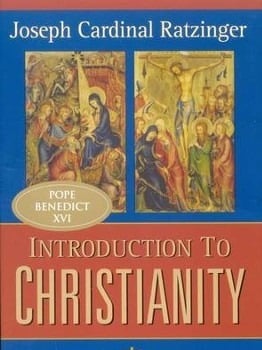An examination of faith for the doubter in all of us
-
 September 23, 2025
September 23, 2025Introduction to Christianity by Cardinal Joseph Ratzinger, who later became Pope Benedict XVI, is remarkably accessible for such a profound theological work. Published in 1968, it offers a systematic exploration of Christian faith through the Apostles’ Creed, making it both a theological treatise and a guide for Christians navigating a secular world. Among its key themes, Ratzinger emphasizes the unity of Jesus’ self and mission, presenting Christianity as a call to unite one’s God-given mission with one’s identity.
Ratzinger begins with “I believe,” which he frames as a relational act of trust in God, not mere intellectual assent. He dedicates sections to God the Father, Jesus Christ, the Holy Spirit, and the Church as each line of the Apostles’ Creed is carefully examined and analyzed both historically and theologically. Central to Ratzinger’s Christology is the idea that Jesus’ self—his identity as the Son of God—and his mission—redemption through the Incarnation and Cross—are inseparable. Ratzinger writes, “In Jesus Christ, being and acting are one; his mission is not something external to his being but flows from it.” To be a Christian, he teaches, is to emulate this unity, integrating one’s self with one’s God-given mission of love and service.
What surprised me most was Ratzinger’s pastoral sensitivity to the struggles of faith in a secular age. He acknowledges doubt as a universal human experience, shared by believers and atheists alike. Early in the book, he writes, “Nobody can completely avoid doubt, least of all the believer. The believer is not a man who has never felt the oppressive power of unbelief, but one who has made a decision in favor of faith in spite of it.” Faith, he explains, is not static certainty but a dynamic choice, a “casting of oneself into the open expanse of God’s truth, a decision to entrust oneself to what cannot be fully grasped or verified.” He compares the believer to someone on a raft amidst a stormy sea: “The believer does not live immune from doubt but is always threatened by the plunge into the void; faith is a decision, a judgment, a venture.”
Ratzinger confronts the temptations against faith even more directly when reflecting on God’s silence, drawing a vivid comparison to the priests of Baal in 1 Kings 18, mocked by Elijah for their god’s unresponsiveness. He writes, “The believer can identify with those priests of Baal who called out in vain. How often does God seem absent, silent, asleep? The mockery of the world echoes Elijah’s taunt: ‘Perhaps your God is asleep or on a journey!’” He acknowledges the pain of this experience: “There are moments when God’s silence is deafening, and the believer stands with the priests of Baal, crying out to a God who does not seem to answer.” Yet, he reframes this silence as an invitation to deeper faith: “It is precisely in this silence that faith is tested and purified, where the believer learns to wait on God, to seek Him in the stillness.” This perspective transforms doubt into an opportunity for spiritual growth, reflecting Ratzinger’s understanding of faith as courageous perseverance.
I recommend Introduction to Christianity to anyone seeking a deeper understanding of Christianity, but especially to those who feel they are struggling with their Catholic faith, or those with loved ones who seem to be struggling with their Catholic faith. The book offers a profound examination of the faith the Church calls us to, while providing an insightful and pastoral acknowledgment of doubt’s challenges and the courage required in “casting oneself” for Christ and His Church.
